Page 123 of 660
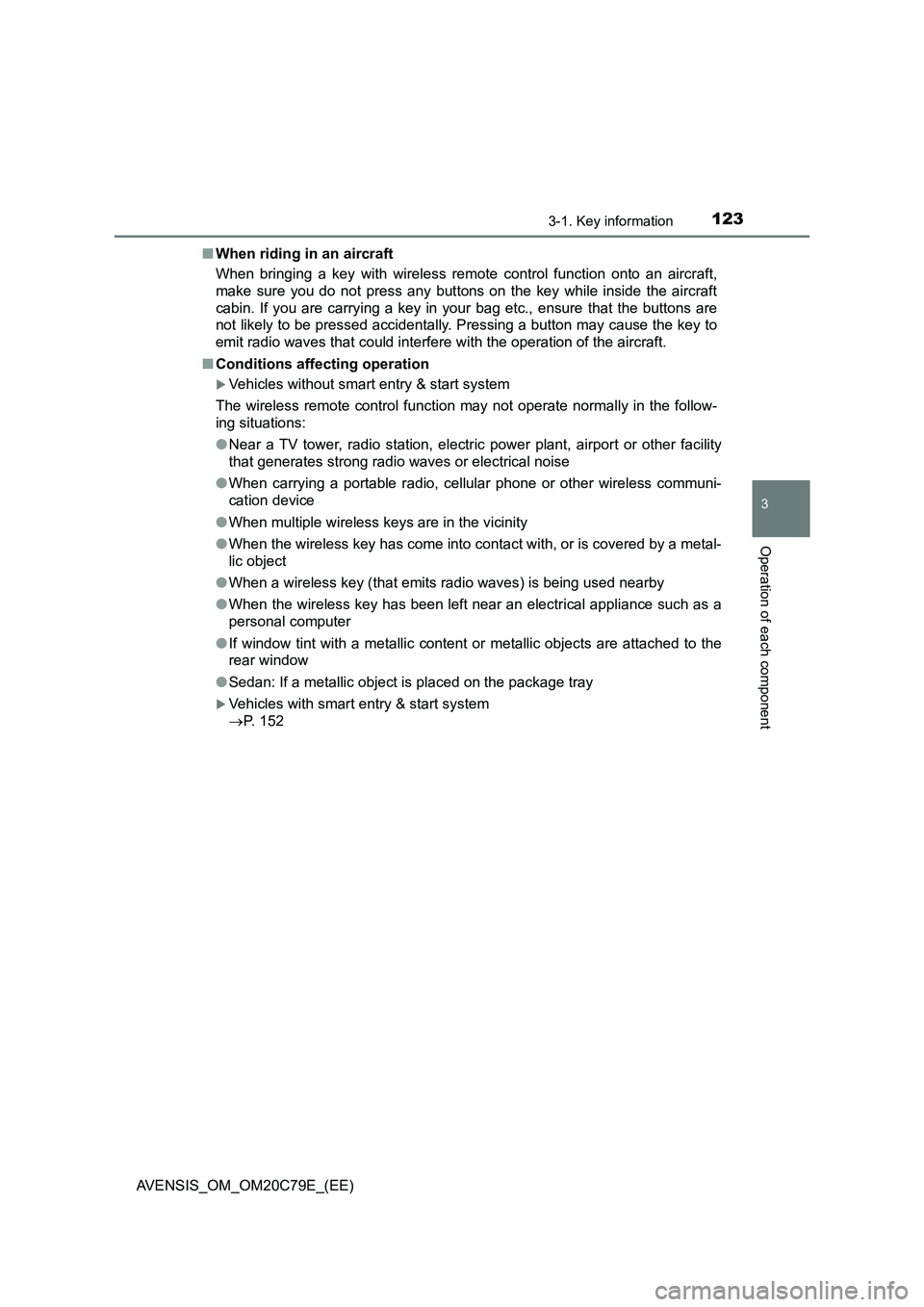
1233-1. Key information
3
Operation of each component
AVENSIS_OM_OM20C79E_(EE)■When riding in an aircraft
When bringing a key with wireless remote control function onto an aircraft,
make sure you do not press any buttons on the key while inside the aircraft
cabin. If you are carrying a key in your bag etc., ensure that the buttons are
not likely to be pressed accidentally. Pressing a button may cause the key to
emit radio waves that could interfere with the operation of the aircraft.
■Conditions affecting operation
Vehicles without smart entry & start system
The wireless remote control function may not operate normally in the follow-
ing situations:
●Near a TV tower, radio station, electric power plant, airport or other facility
that generates strong radio waves or electrical noise
●When carrying a portable radio, cellular phone or other wireless communi-
cation device
●When multiple wireless keys are in the vicinity
●When the wireless key has come into contact with, or is covered by a metal-
lic object
●When a wireless key (that emits radio waves) is being used nearby
●When the wireless key has been left near an electrical appliance such as a
personal computer
●If window tint with a metallic content or metallic objects are attached to the
rear window
●Sedan: If a metallic object is placed on the package tray
Vehicles with smart entry & start system
P. 152
Page 152 of 660
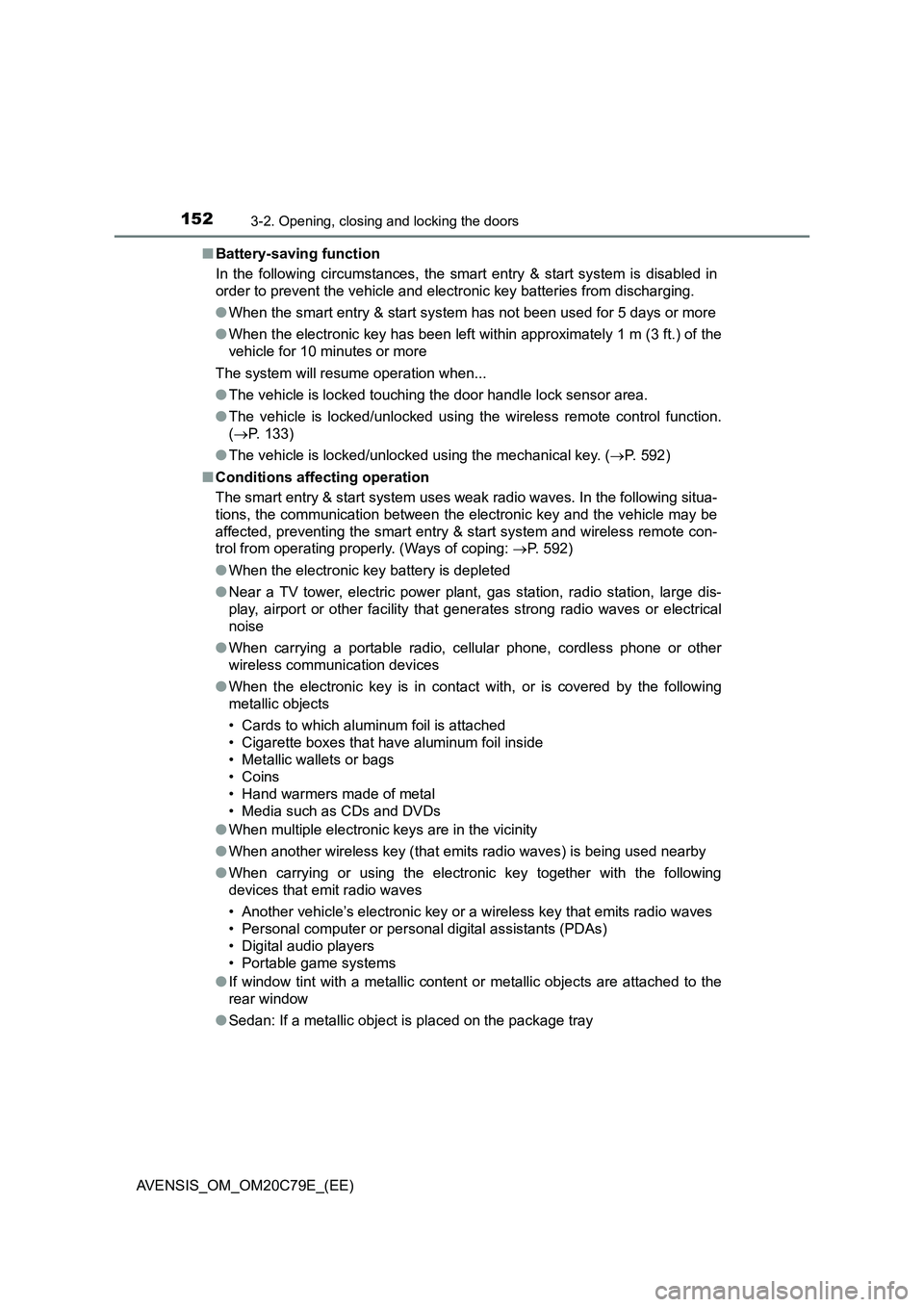
1523-2. Opening, closing and locking the doors
AVENSIS_OM_OM20C79E_(EE)■Battery-saving function
In the following circumstances, the smart entry & start system is disabled in
order to prevent the vehicle and electronic key batteries from discharging.
●When the smart entry & start system has not been used for 5 days or more
●When the electronic key has been left within approximately 1 m (3 ft.) of the
vehicle for 10 minutes or more
The system will resume operation when...
●The vehicle is locked touching the door handle lock sensor area.
●The vehicle is locked/unlocked using the wireless remote control function.
(P. 133)
●The vehicle is locked/unlocked using the mechanical key. (P. 592)
■Conditions affecting operation
The smart entry & start system uses weak radio waves. In the following situa-
tions, the communication between the electronic key and the vehicle may be
affected, preventing the smart entry & start system and wireless remote con-
trol from operating properly. (Ways of coping: P. 592)
●When the electronic key battery is depleted
●Near a TV tower, electric power plant, gas station, radio station, large dis-
play, airport or other facility that generates strong radio waves or electrical
noise
●When carrying a portable radio, cellular phone, cordless phone or other
wireless communication devices
●When the electronic key is in contact with, or is covered by the following
metallic objects
• Cards to which aluminum foil is attached
• Cigarette boxes that have aluminum foil inside
• Metallic wallets or bags
• Coins
• Hand warmers made of metal
• Media such as CDs and DVDs
●When multiple electronic keys are in the vicinity
●When another wireless key (that emits radio waves) is being used nearby
●When carrying or using the electronic key together with the following
devices that emit radio waves
• Another vehicle’s electronic key or a wireless key that emits radio waves
• Personal computer or personal digital assistants (PDAs)
• Digital audio players
• Portable game systems
●If window tint with a metallic content or metallic objects are attached to the
rear window
●Sedan: If a metallic object is placed on the package tray
Page 168 of 660
1683-3. Adjusting the seats
AVENSIS_OM_OM20C79E_(EE)
Rear seats
■Before folding down
Stow the seat belt buckles as
shown.
Lower each of the head
restraints while pushing the
lock release button.
■Folding down the seatbacks
Pull the lever to unlock the
seatback and then fold the
seatback down.
The seatbacks of the rear seats can be folded down.
Folding down the rear seatbacks
1
2
Page 169 of 660
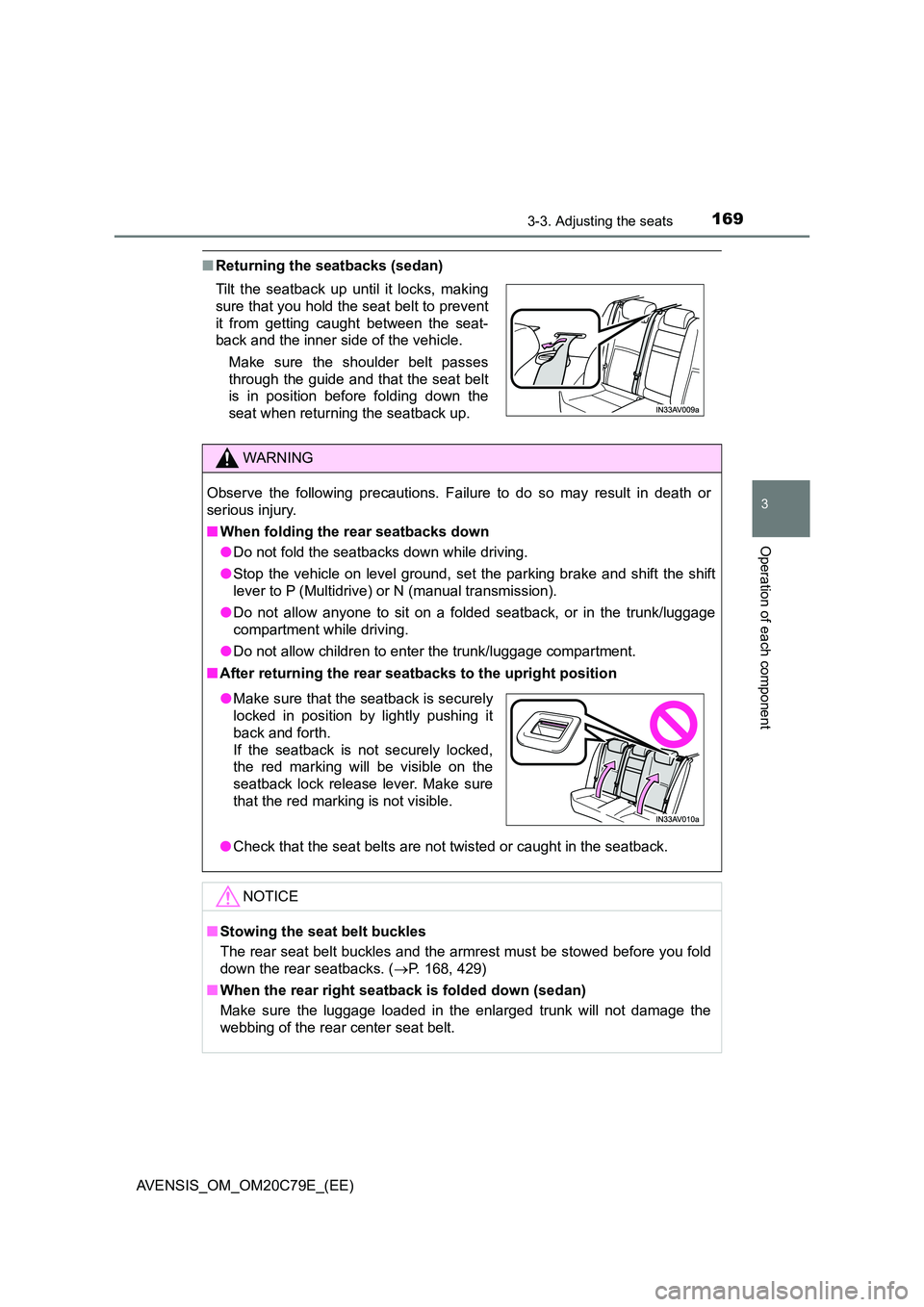
1693-3. Adjusting the seats
3
Operation of each component
AVENSIS_OM_OM20C79E_(EE)
■Returning the seatbacks (sedan)
Tilt the seatback up until it locks, making
sure that you hold the seat belt to prevent
it from getting caught between the seat-
back and the inner side of the vehicle.
Make sure the shoulder belt passes
through the guide and that the seat belt
is in position before folding down the
seat when returning the seatback up.
WARNING
Observe the following precautions. Failure to do so may result in death or
serious injury.
■ When folding the rear seatbacks down
● Do not fold the seatbacks down while driving.
● Stop the vehicle on level ground, set the parking brake and shift the shift
lever to P (Multidrive) or N (manual transmission).
● Do not allow anyone to sit on a folded seatback, or in the trunk/luggage
compartment while driving.
● Do not allow children to enter the trunk/luggage compartment.
■ After returning the rear seatbacks to the upright position
● Check that the seat belts are not twisted or caught in the seatback.
NOTICE
■Stowing the seat belt buckles
The rear seat belt buckles and the armrest must be stowed before you fold
down the rear seatbacks. ( P. 168, 429)
■ When the rear right seatback is folded down (sedan)
Make sure the luggage loaded in the enlarged trunk will not damage the
webbing of the rear center seat belt.
● Make sure that the seatback is securely
locked in position by lightly pushing it
back and forth.
If the seatback is not securely locked,
the red marking will be visible on the
seatback lock release lever. Make sure
that the red marking is not visible.
Page 173 of 660
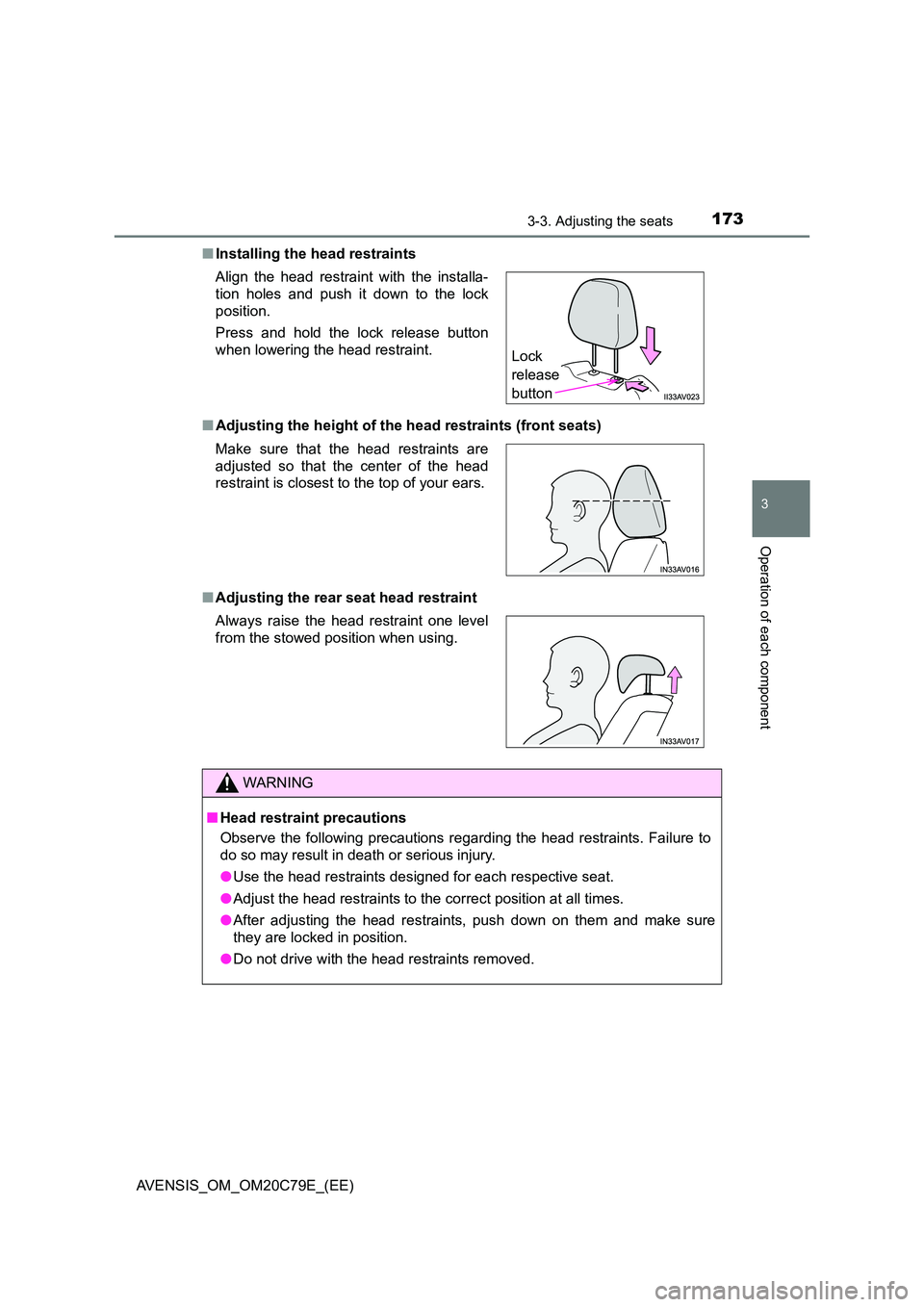
1733-3. Adjusting the seats
3
Operation of each component
AVENSIS_OM_OM20C79E_(EE)
■ Installing the head restraints
■ Adjusting the height of the head restraints (front seats)
■ Adjusting the rear seat head restraint
Align the head restraint with the installa-
tion holes and push it down to the lock
position.
Press and hold the lock release button
when lowering the head restraint.
Make sure that the head restraints are
adjusted so that the center of the head
restraint is closest to the top of your ears.
Always raise the head restraint one level
from the stowed position when using.
WARNING
■ Head restraint precautions
Observe the following precautions regarding the head restraints. Failure to
do so may result in death or serious injury.
● Use the head restraints designed for each respective seat.
● Adjust the head restraints to the correct position at all times.
● After adjusting the head restraints, push down on them and make sure
they are locked in position.
● Do not drive with the head restraints removed.
Lock
release
button
Page 185 of 660
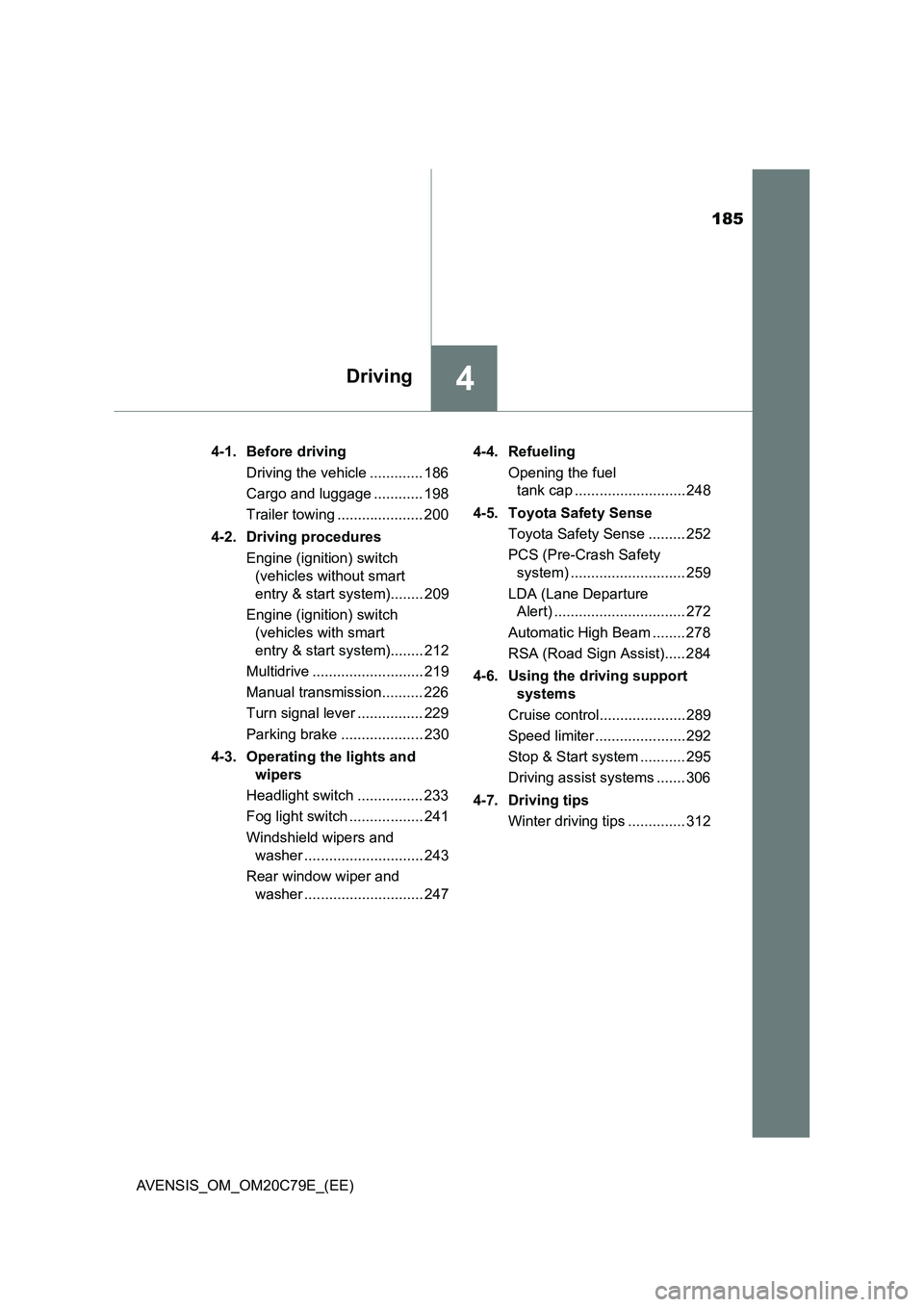
185
4Driving
AVENSIS_OM_OM20C79E_(EE)4-1. Before driving
Driving the vehicle ............. 186
Cargo and luggage ............ 198
Trailer towing ..................... 200
4-2. Driving procedures
Engine (ignition) switch
(vehicles without smart
entry & start system)........ 209
Engine (ignition) switch
(vehicles with smart
entry & start system)........ 212
Multidrive ........................... 219
Manual transmission.......... 226
Turn signal lever ................ 229
Parking brake .................... 230
4-3. Operating the lights and
wipers
Headlight switch ................ 233
Fog light switch .................. 241
Windshield wipers and
washer ............................. 243
Rear window wiper and
washer ............................. 2474-4. Refueling
Opening the fuel
tank cap ........................... 248
4-5. Toyota Safety Sense
Toyota Safety Sense ......... 252
PCS (Pre-Crash Safety
system) ............................ 259
LDA (Lane Departure
Alert) ................................ 272
Automatic High Beam ........ 278
RSA (Road Sign Assist)..... 284
4-6. Using the driving support
systems
Cruise control..................... 289
Speed limiter ...................... 292
Stop & Start system ........... 295
Driving assist systems ....... 306
4-7. Driving tips
Winter driving tips .............. 312
Page 189 of 660
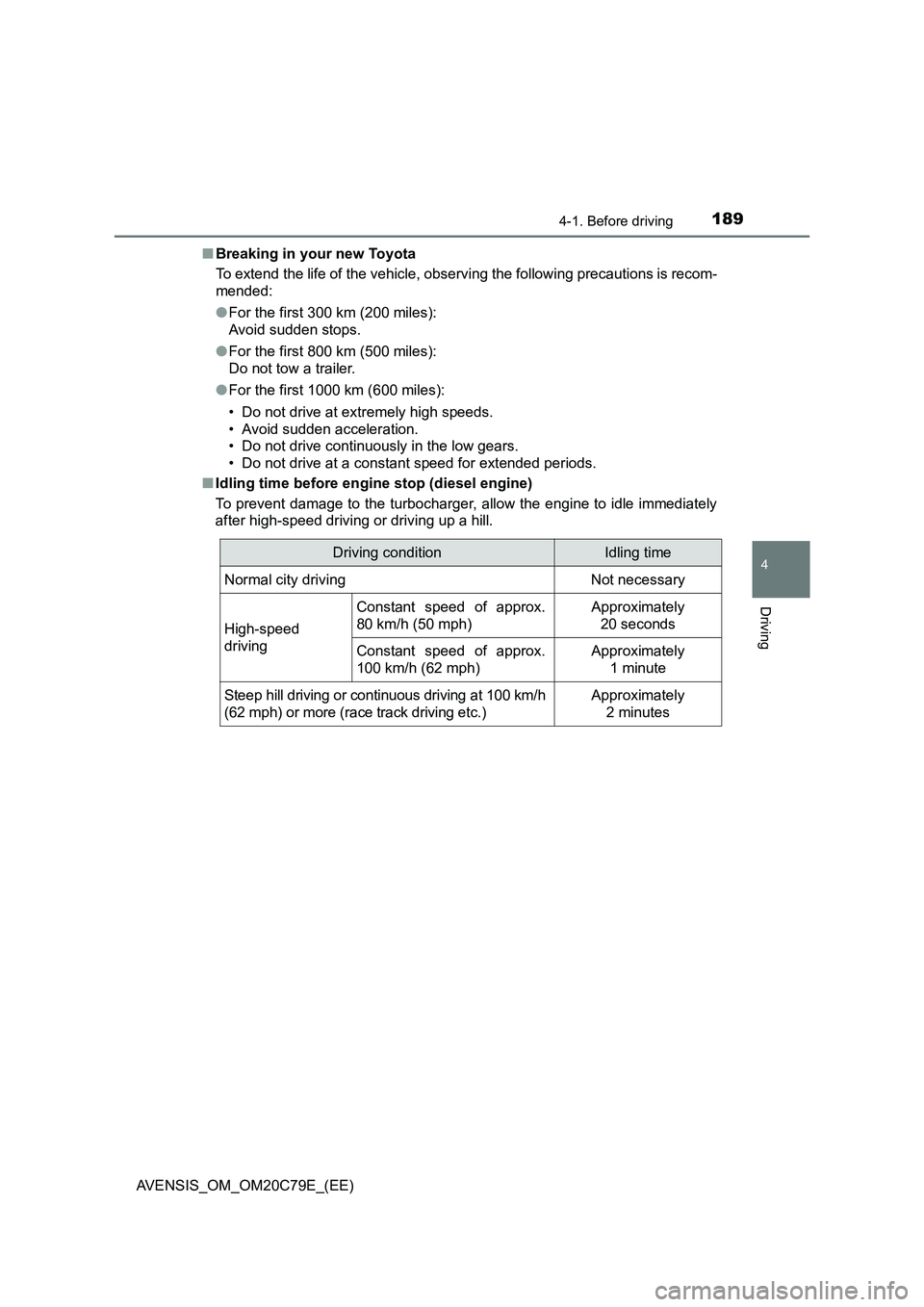
1894-1. Before driving
4
Driving
AVENSIS_OM_OM20C79E_(EE)■Breaking in your new Toyota
To extend the life of the vehicle, observing the following precautions is recom-
mended:
●For the first 300 km (200 miles):
Avoid sudden stops.
●For the first 800 km (500 miles):
Do not tow a trailer.
●For the first 1000 km (600 miles):
• Do not drive at extremely high speeds.
• Avoid sudden acceleration.
• Do not drive continuously in the low gears.
• Do not drive at a constant speed for extended periods.
■Idling time before engine stop (diesel engine)
To prevent damage to the turbocharger, allow the engine to idle immediately
after high-speed driving or driving up a hill.
Driving conditionIdling time
Normal city drivingNot necessary
High-speed
driving
Constant speed of approx.
80 km/h (50 mph)Approximately
20 seconds
Constant speed of approx.
100 km/h (62 mph)Approximately
1 minute
Steep hill driving or continuous driving at 100 km/h
(62 mph) or more (race track driving etc.)Approximately
2 minutes
Page 198 of 660
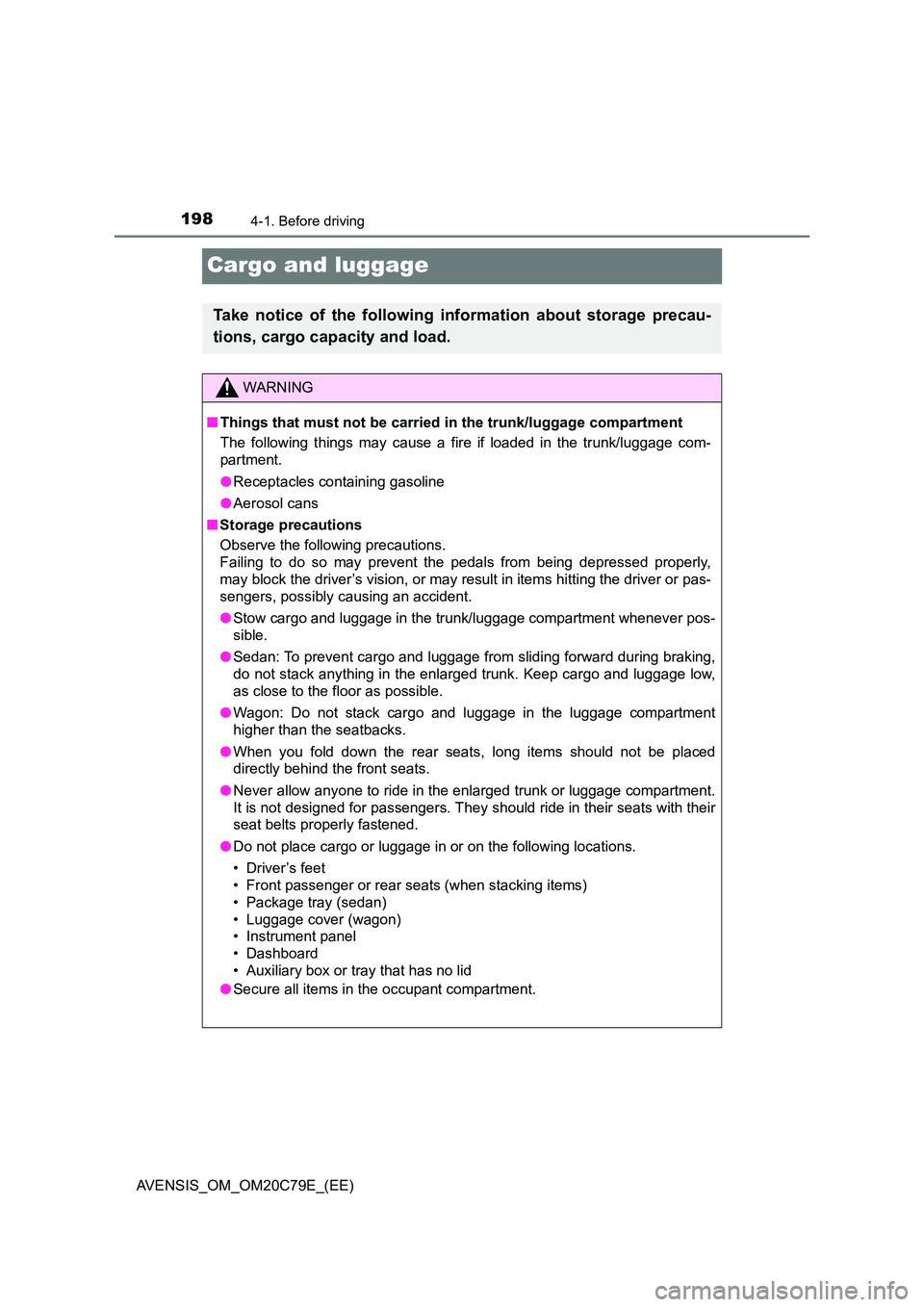
1984-1. Before driving
AVENSIS_OM_OM20C79E_(EE)
Cargo and luggage
Take notice of the following information about storage precau-
tions, cargo capacity and load.
WARNING
■ Things that must not be carried in the trunk/luggage compartment
The following things may cause a fire if loaded in the trunk/luggage com-
partment.
● Receptacles containing gasoline
● Aerosol cans
■ Storage precautions
Observe the following precautions.
Failing to do so may prevent the pedals from being depressed properly,
may block the driver’s vision, or may re sult in items hitting the driver or pas-
sengers, possibly causing an accident.
● Stow cargo and luggage in the trunk/luggage compartment whenever pos-
sible.
● Sedan: To prevent cargo and luggage from sliding forward during braking,
do not stack anything in the enlarged trunk. Keep cargo and luggage low,
as close to the floor as possible.
● Wagon: Do not stack cargo and luggage in the luggage compartment
higher than the seatbacks.
● When you fold down the rear seats, long items should not be placed
directly behind the front seats.
● Never allow anyone to ride in the enlarged trunk or luggage compartment.
It is not designed for passengers. They should ride in their seats with their
seat belts properly fastened.
● Do not place cargo or luggage in or on the following locations.
• Driver’s feet
• Front passenger or rear seats (when stacking items)
• Package tray (sedan)
• Luggage cover (wagon)
• Instrument panel
• Dashboard
• Auxiliary box or tray that has no lid
● Secure all items in the occupant compartment.